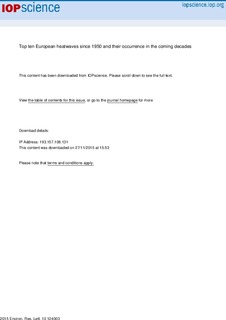Top ten European heatwaves since 1950 and their occurrence in the coming decades
Journal article, Peer reviewed
Published version
Permanent lenke
http://hdl.handle.net/11250/2600188Utgivelsesdato
2015Metadata
Vis full innførselSamlinger
- Journal articles [478]
Sammendrag
The Russian heatwave in 2010 killed tens of thousands of people, and was by far the worst event in Europe since at least 1950, according to recent studies and a novel universal heatwave index capturing both the duration and magnitude of heatwaves. Here, by taking an improved version of this index, namely the heat wave magnitude index daily, we rank the top ten European heatwaves that occurred in the period 1950–2014, and show the spatial distribution of the magnitude of the most recent heatwave in summer 2015. We demonstrate that all these events had a strong impact reported in historical newspapers. We further reveal that the 1972 heatwave in Finland had a comparable spatial extent and magnitude as the European heatwave of 2003, considered the second strongest heatwave of the observational era. In the next two decades(2021–2040), regional climate projections suggest that Europe experiences an enhanced probability for heatwaves comparable to or greater than the magnitude, extent and duration of the Russian heatwave in 2010. We demonstrate that the probability of experiencing a major European heatwave in the coming decades is higher in RCP8.5 than RCP4.5 even though global mean temperature projections do not differ substantially. This calls for a proactive vulnerability assessment in Europe in support of formulating heatwave adaptation strategies to reduce the adverse impacts of heatwaves.
